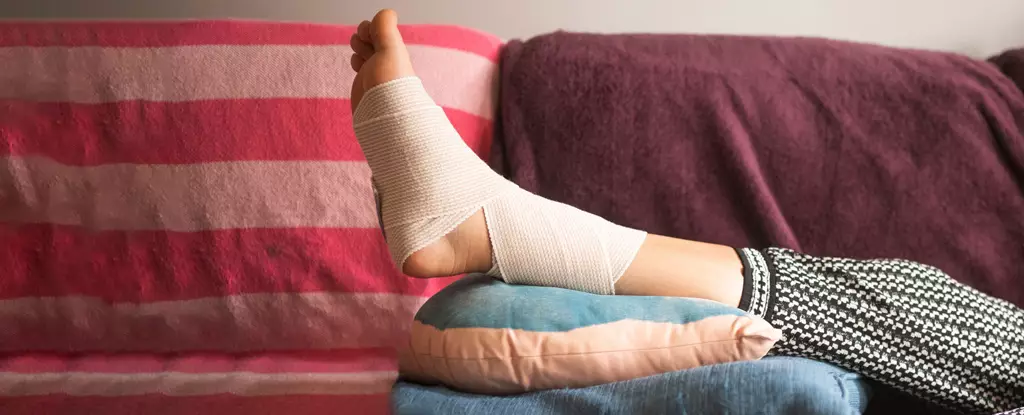The intricate relationship between the brain and body often goes unnoticed, particularly concerning injuries like ankle sprains. Traditionally, ankle sprains have been perceived as localized injuries affecting only the musculoskeletal system, with the ensuing emphasis predominantly on physical rehabilitation methods. However, recent research reveals that such injuries could also prompt significant changes in the brain’s functioning, particularly concerning pain perception and movement control. This emerging understanding encourages a multifaceted approach to injury recovery, recognizing the brain’s adaptability, or plasticity, beyond the physical damage that occurs to tissues.
Research conducted at the University of Canberra highlights the pivotal role of sensory perception in movement control, pushing the boundaries of traditional rehabilitation methodologies. Ashley Marchant, a doctoral student, demonstrated that variations in weight or muscle load significantly influence how accurately we perceive movement. This nuanced relationship implies that when the load is closely aligned with normal earth gravity, our movement sense remains acute; conversely, a decrease in load results in diminished accuracy. This revelation calls for a reevaluation of existing practices which have historically prioritized resistance training and cardiovascular exercises. If the brain’s perception of movement is compromised, as revealed by these findings, rehabilitation must extend beyond mere physical exercises to encompass sensory awareness training.
A critical component of sports medicine involves ensuring athletes return to their peak performance without jeopardizing their health. Research indicates that an athlete’s risk of incurring another injury post-recovery can increase exponentially, extending from two to eight times higher than that of an uninjured athlete. Such alarming statistics indicate a deficiency in traditional treatment protocols, suggesting a deeper reliance on muscle performance rather than understanding underlying changes in sensory processing. By analyzing how sensory input functions, researchers can begin addressing this gap, focusing on devising strategies that consider the athlete’s holistic cognitive and sensory state rather than treating just the physical manifestation of injury.
With over two decades of research, scientists have developed advanced tools to evaluate the quality of sensory input that the brain receives. Such innovations underpin our comprehension of movement perception, enabling practitioners to collect data on various sensory systems, such as the vestibular system, visual cues, and proprioception in the lower limbs. By objectively measuring how effectively a person gathers movement information, practitioners can identify which areas necessitate rehab or training—an essential distinction for optimizing recovery. This level of assessment not only contributes to athletic rehabilitation but can also be instrumental in fall prevention strategies for the elderly.
Astronauts present a compelling case study for the intersection of sensory input and movement control. In microgravity environments, they often rely on improvised movements, leading to reduced sensory feedback from their lower limbs. This disruption can result in the brain minimizing connections typically engaged in movement control. Although astronauts can manage in space, the readjustment to Earth’s gravity can be challenging and fraught with risk. Such phenomena may parallel athlete experiences post-injury, where altered movement patterns due to compensatory mechanisms results in inadequate sensory feedback, potentially increasing the likelihood of subsequent injuries.
The correlation between previous injuries and future occurrences highlights an essential facet of recovery—adverse changes in movement control processes within the brain. Research indicates that a history of injury serves as the premier predictor of future injuries, suggesting that adaptations occur in the brain that may persist despite the physical healing of tissues. Thus, a more profound understanding of an athlete’s sensory perceptions and movement control can illuminate effective preventative strategies and rehabilitation tailored to their unique recovery trajectories.
A novel approach dubbed precision health is gaining traction in the medical field, focusing on personalized health interventions based on an individual’s sensory data, genetic makeup, and lifestyle factors. This transformative direction implies that health care solutions can be more finely tuned to address specific sensorimotor capabilities, thereby enhancing rehabilitation for athletes and fall prevention in seniors. Employing technologies and artificial intelligence in this context may revolutionize how we understand and implement movement control strategies, effectively bridging gaps in traditional rehabilitative frameworks.
The evolving comprehension of sensory input’s integral role in movement control is reshaping injury recovery paradigms. Adopting these insights could lead to more effective strategies for rehabilitation, a deeper understanding of athletic potential, and improved health outcomes for all age groups. Emphasizing the brain’s influence in rehabilitation not only enhances performance outcomes but also offers a groundbreaking perspective that balances both the physical and cognitive aspects of human movement.


Leave a Reply